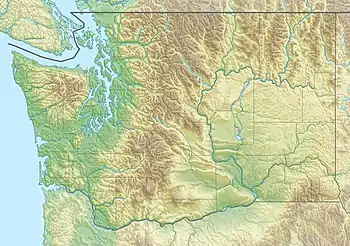 Olympia Seattle Tacoma | |
| UTC time | 1949-04-13 19:55:43 |
|---|---|
| ISC event | 896466 |
| USGS-ANSS | ComCat |
| Local date | April 13, 1949 |
| Local time | 11:55:44 |
| Duration | ~ 20 seconds[1] |
| Magnitude | 6.7 Mw[2] |
| Depth | 50 km (31 mi)[2] |
| Epicenter | 47°00′N 122°32′W / 47.0°N 122.53°W[2] |
| Areas affected | Puget Sound region Washington United States |
| Total damage | $25 million[3] |
| Max. intensity | VIII (Severe)[3] |
| Peak acceleration | 0.25 g[1] |
| Casualties | 8 killed[3] At least 64 injured[4] |
The 1949 Olympia earthquake occurred on April 13 at 11:55:44 local time with a moment magnitude of 6.7 and a maximum Mercalli Intensity of VIII (Severe). The shock was located in the area between Olympia and Tacoma, and was felt throughout the state, as well as parts of Oregon, British Columbia, Idaho, and Montana. It is the largest recorded earthquake to occur in the Puget Sound region of Washington. Eight people were killed, a minimum of 64 people were injured, and the total damage is estimated at $25 million.
Damage
Damage in Olympia from the earthquake was estimated between $500,000 and $1 million by Governor Arthur B. Langlie.[5] Eight buildings on the State Capital campus were damaged by the earthquake, as well as the Old Capitol Building in downtown Olympia.[6] A 23-ton cradle on the east tower of the Tacoma Narrows Bridge fell 500 feet (150 m), injuring two men. The earthquake caused geysers to explode along the railroad track in the Tacoma tidal flats and in Puyallup.
In Seattle, nearly every building in the Pioneer Square neighborhood was affected in some way, with damage ranging from lost parapets to entire floors and in some cases entire buildings needing to be demolished over the following years. Most buildings still show the scars of earthquake damage and the mostly hasty repairs made to them.
Chimneys throughout western Washington collapsed.[7] Severe damage were recorded at schools in Adna and Napavine, and structural losses to buildings in Centralia's downtown district. The earthquake caused catastrophic loss to two schools in Chehalis, a state training school for youths and West Side Elementary; neither were rebuilt.[8][9]
Eight people were killed, including young crossing guard Marvin Klegman who shielded a second-grader from falling bricks.[7] At least 64 people were injured, and the total damage is estimated at $25 million.
See also
References
- 1 2 Baker, G. E.; Langston, C. A. (1987), "Source parameters of the 1949 magnitude 7.1 south Puget Sound, Washington, earthquake as determined from long-period body waves and strong ground motions", Bulletin of the Seismological Society of America, 77 (5): 1546, Bibcode:1987BuSSA..77.1530B, doi:10.1785/BSSA0770051530
- 1 2 3 ISC (2014), ISC-GEM Global Instrumental Earthquake Catalogue (1900–2009), Version 1.05, International Seismological Centre
- 1 2 3 Stover, C. W.; Coffman, J. L. (1993), Seismicity of the United States, 1568–1989 (Revised), U.S. Geological Survey Professional Paper 1527, United States Government Printing Office, pp. 380, 385, 386
- ↑ "Earthquake damage in Pioneer Square, Seattle, April 13, 1949". Museum of History and Industry. Retrieved November 16, 2017.
- ↑ "Olympia Damage Half Million, Says Langlie". The Seattle Daily Times. April 19, 1949. p. 7.
- ↑ "Earthquake Listed as Major; 5 Dead; Damage in Millions". The Seattle Daily Times. April 13, 1949. p. 1.
- 1 2 McNair-Huff, Rob & Natalie (2016). Washington Disasters. Rowman & Littlefield. pp. 129–134. ISBN 978-1-4930-1322-7.
- ↑ "1949 Was Earth-Shaking, Heart-Breaking Time Here". The Chronicle. February 17, 2007. Retrieved December 22, 2021.
- ↑ Jones, Pat (March 31, 2007). "Florence Kennicott Lived a Colorful Life". The Chronicle. p. A3. Retrieved December 22, 2021.
Further reading
- Hodgson, J. H.; Storey, R. S. (1954), "Direction of faulting in some of the larger earthquakes of 1949", Bulletin of the Seismological Society of America, 44 (1): 57–83, Bibcode:1954BuSSA..44...57H, doi:10.1785/BSSA0440010057
- Ichinose, G. A.; Thio, H. K.; Somerville, P. G. (2006), "Moment Tensor and Rupture Model for the 1949 Olympia, Washington, Earthquake and Scaling Relations for Cascadia and Global Intraslab Earthquakes", Bulletin of the Seismological Society of America, 96 (3): 1029–1037, Bibcode:2006BuSSA..96.1029I, doi:10.1785/0120050132
External links
- Earthquake hits Puget Sound area on April 13, 1949 – HistoryLink
- The International Seismological Centre has a bibliography and/or authoritative data for this event.
- Earthquake Hazards – USGS